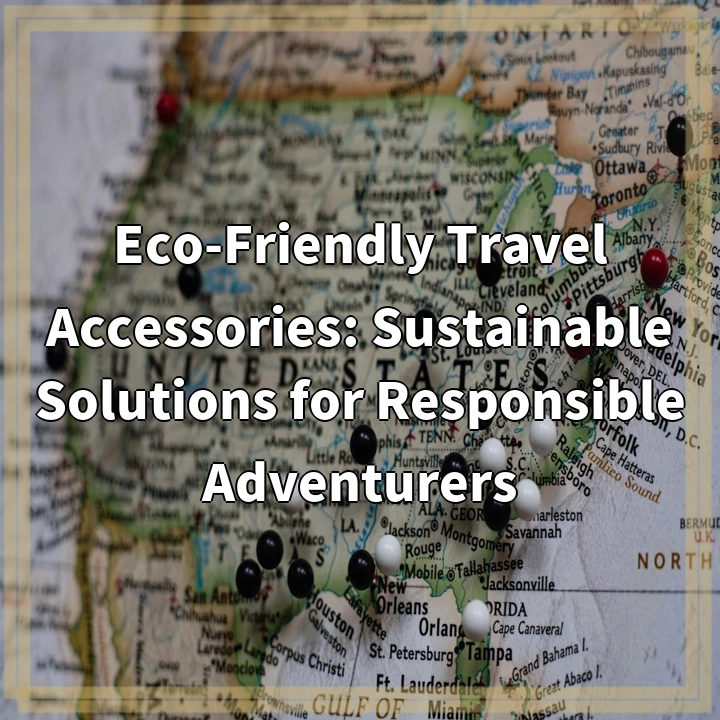
What it is:
When it comes to travel, more and more people are becoming conscious of their environmental impact. Eco-friendly travel accessories have gained popularity as a way for responsible adventurers to reduce their carbon footprint and promote sustainable tourism. These accessories are designed with environmentally friendly materials and production methods, allowing travelers to minimize waste and support businesses that prioritize sustainability.
Real-World Problems:
Despite the growing demand for eco-friendly travel accessories, there are still several real-world problems associated with their adoption and use.
Limited Availability:
One challenge faced by responsible adventurers is the limited availability of eco-friendly travel accessories. While there are some options on the market, they may not be as accessible or well-known as traditional travel gear. This can make it difficult for travelers to find and purchase eco-friendly alternatives, forcing them to opt for less sustainable options.
Higher Cost:
Another barrier to widespread adoption is the higher cost associated with eco-friendly travel accessories. Due to the use of sustainable materials and production methods, these products often come with a higher price tag compared to their non-eco-friendly counterparts. This can be a deterrent for budget-conscious travelers who prioritize affordability over sustainability.
Lack of Information:
Many travelers may not be aware of the environmental impact of their travel accessories or the sustainable alternatives available to them. The lack of information and education on eco-friendly options can prevent individuals from making informed purchasing decisions. Additionally, misleading marketing claims and greenwashing practices by some companies can further confuse consumers and make it challenging to differentiate between genuinely eco-friendly products and those with minimal sustainability benefits.
Durability and Performance:
Some eco-friendly travel accessories may face challenges in terms of durability and performance. Certain sustainable materials may not be as long-lasting or as functional as traditional travel gear made from synthetic materials. This can create concerns for travelers who prioritize functionality and long-term usability over sustainability.
Change in Consumer Behavior:
Changing consumer behavior is a significant hurdle when it comes to adopting eco-friendly travel accessories. Many travelers are accustomed to the convenience and familiarity of traditional gear and may be resistant to change. Overcoming this resistance requires education, awareness campaigns, and efforts to shift societal norms around sustainability and responsible travel.
Overall, while eco-friendly travel accessories offer sustainable solutions for responsible adventurers, it is important to address the real-world problems associated with their adoption. By increasing availability, addressing cost concerns, improving information dissemination, ensuring quality and performance, and promoting a shift in consumer behavior, we can create a more sustainable travel industry that minimizes our environmental impact.

Solutions:
Addressing the challenges associated with eco-friendly travel accessories requires a collective effort from travelers, businesses, and the industry as a whole. Here are some potential solutions:
Increased Accessibility and Availability:
Efforts should be made to make eco-friendly travel accessories more accessible and widely available. This can be done by partnering with retailers, online marketplaces, and travel gear manufacturers to increase the visibility and availability of sustainable options.
Affordability:
To encourage broader adoption, the cost of eco-friendly travel accessories needs to be more affordable. This can be achieved through economies of scale, government subsidies or incentives, and collaborations between manufacturers and sustainable material suppliers.
Education and Information:
Providing comprehensive and accurate information about the environmental impact of travel accessories is vital. This can be done through education campaigns, labeling systems, and certification programs to help consumers make informed choices. Additionally, fighting greenwashing practices and ensuring transparency in marketing claims is essential.
Improving Durability and Performance:
Developing and promoting sustainable materials that are durable and high-performing can help address concerns about the functionality of eco-friendly travel accessories. Research and development in this area can lead to innovative solutions that combine sustainability with long-lasting, reliable performance.
Cultural Shift:
Shifting consumer behavior towards sustainability requires a cultural shift and the promotion of responsible travel practices. Educating travelers on the importance of minimizing their environmental impact and showcasing the benefits of using eco-friendly accessories can create a demand for sustainable products.
Overall, by increasing accessibility, affordability, and information, while also focusing on durability and performance, and driving a cultural shift towards responsible travel, we can overcome the challenges associated with eco-friendly travel accessories and pave the way for a more sustainable future in the travel industry.















